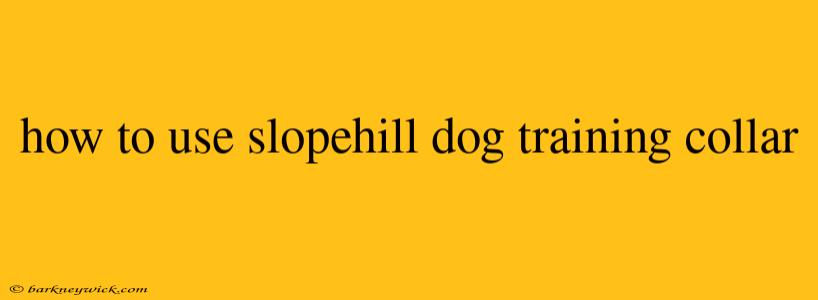Mastering the Slopehill Dog Training Collar: A Guide to Safe and Effective Training
Remember the first time I tried using a dog training collar? I was excited to teach my pup, Max, some basic commands, but the experience was a disaster. The collar felt bulky, the vibrations were harsh, and Max seemed terrified. Thankfully, I stumbled upon the Slopehill dog training collar, and it revolutionized our training sessions.
Why I Love the Slopehill Collar
In my opinion, the Slopehill collar stands out due to its focus on safety and gentle correction. It utilizes safe and effective technology that prioritizes your dog's comfort and well-being. Unlike traditional collars that rely solely on shock, the Slopehill collar offers a range of training modes, including vibrations, tones, and static stimulation (which can be adjusted based on your dog's sensitivity).
How to Use the Slopehill Dog Training Collar
1. Introduction & Familiarization:
- Start by introducing the collar to your dog in a positive way. Let them sniff and explore it without attaching it.
- Reward them with treats and praise for their calm and curious behavior.
- Gradually increase the time spent wearing the collar, ensuring it fits comfortably and securely.
2. Choosing the Right Training Mode:
- Start with the gentlest mode, usually vibrations or tones.
- Gradually increase the intensity level if needed, but always observe your dog's reaction closely.
- Consult the Slopehill website or manual for detailed instructions on the specific modes and their purpose.
3. Training Techniques:
- Use the collar in conjunction with positive reinforcement techniques.
- Always pair the correction with a clear verbal cue.
- Reward desired behavior consistently with treats, praise, and playtime.
- Avoid using the collar excessively or for punishment. It should only be used as a tool to guide and redirect your dog.
4. Troubleshooting:
- Make sure the collar fits snugly but not too tightly.
- Check the battery life regularly.
- Consult with a professional dog trainer if you face any difficulties or if your dog shows signs of discomfort.
Important Notes:
- The Slopehill collar is not a substitute for proper training techniques.
- It is crucial to seek professional help if you are unsure about how to use the collar safely and effectively.
- Remember, the ultimate goal is to train your dog in a way that is both safe and effective, while building a strong bond and positive relationship.
Resources:
- Slopehill website: www.slopehill.com (for detailed instructions, user manuals, and customer support)
- Professional dog trainer: Find certified trainers through organizations like the Certification Council for Professional Dog Trainers (CCPDT) or the International Association of Animal Behavior Consultants (IAABC).
My Experience:
Thanks to the Slopehill collar and the guidance of a certified trainer, I've been able to teach Max basic commands like "sit," "stay," and "come" with ease. It's been a rewarding experience for both of us, and I can confidently say that the Slopehill collar has been a game-changer in our training journey.
Conclusion:
Using a dog training collar can be a valuable tool for training your dog, but choosing the right one and using it responsibly is crucial. The Slopehill collar offers a safe and effective alternative to traditional shock collars, empowering you to train your dog with compassion and understanding. By following these tips and seeking professional guidance when needed, you can utilize the Slopehill collar to build a strong bond with your dog and achieve your training goals.
